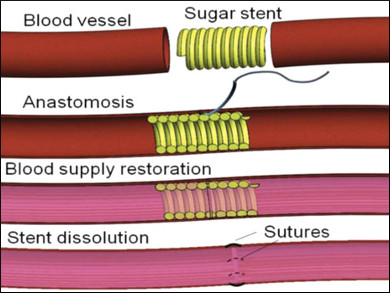Reconnecting small blood vessels under a microscope (“microvascular anastomosis”) is an important but time-consuming and very difficult step in transplant or reconstructive surgeries. Problems during this process can cause blood clots and failed transplants.
In veins, mechanical “anastomotic coupling devices” can be used to connect the vessels instead of sutures (stitches). They consist of two rigid rings that are fixed to both vessels. The two rings can then easily be connected to each other. This reduces the chance of blood clots. For arteries, however, such couplers cannot be used. A method that makes the suturing of arteries easier would, thus, be useful.
Ali Khademhosseini, Harvard Medical School, Boston, MA, USA, King Abdulaziz University, Jeddah, Saudi Arabia, and University of California, Los Angeles, USA, Ali Tamayol, Harvard Medical School and University of Nebraska, Lincoln, USA, and colleagues have developed 3D-printed, dissolvable, sugar-based stents that act as an assistive tool for suturing blood vessels. The team mixed glucose and sucrose as the basis for the stents, dextran as a plasticizer, and sodium citrate to prevent blood clots. An extrusion-based printer was then used to prepare stents in the required shape and size from the sugar-based mixture. This fabrication procedure is fast and can be performed in the operating room.
The prepared stents stick to walls of blood vessels and can keep them together during suturing (pictured). This makes the suturing process easier. After blood flow is restored, the material dissolves within minutes.
According to the researchers, the sugar-based stents could also be used to avoid the need for sutures altogether and allow the use of surgical glue, instead. Surgical glues can usually leak into the vessels, which causes blockages. The stents could prevent this.
- 3D-Printed Sugar-Based Stents Facilitating Vascular Anastomosis,
Ali Farzin, Amir K. Miri, Fatemeh Sharifi, Negar Faramarzi, Arian Jaberi, Azadeh Mostafavi, Ricky Solorzano, Yu Shrike Zhang, Nasim Annabi, Ali Khademhosseini, Ali Tamayol,
Adv. Healthcare Mater. 2018.
https://doi.org/10.1002/adhm.201800702




